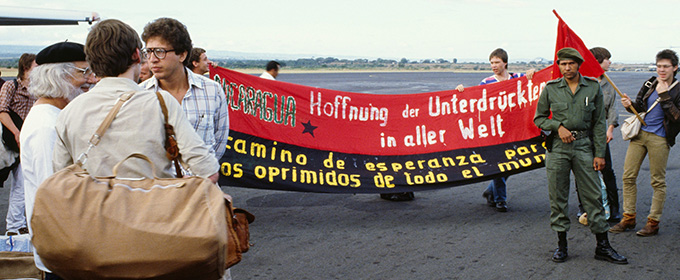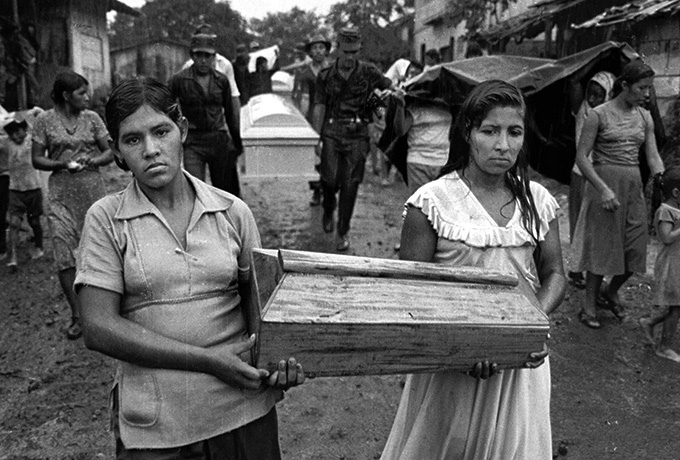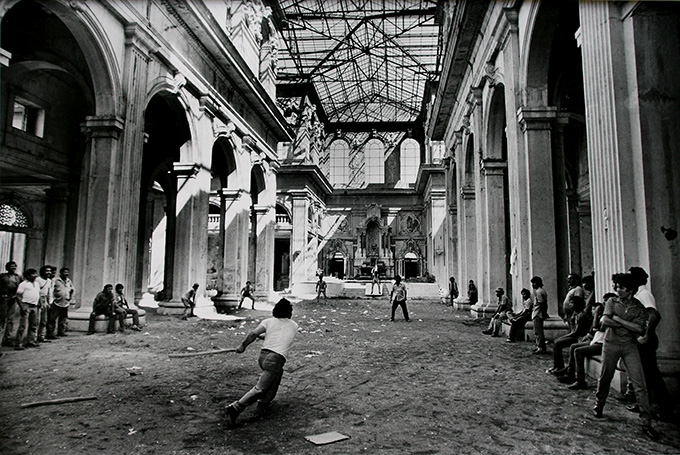Farewell to Nicaragua: Part 1
By Matthias Schindler
From total enthusiasm to complete disappointment
Farewell to Nicaragua, part 1 of 4, running over the next two and half weeks
On 21 December 1983, I set foot on Nicaraguan soil for the very first time. Although I had been active in the solidarity movement with Nicaragua since the fall of the dictator Somoza and the coming to power of the Sandinistas, this was the day that changed my life and linked me to a revolutionary liberation movement in the Third World for several decades. On 21 November 2021, I left Nicaragua for the last time. I was saying goodbye to a country to whose liberation and development I had dedicated over forty years of my political life. I left behind a country whose revolution had been betrayed and irretrievably destroyed by some of its own former leaders.
Both dates had deep political and emotional significance for me. The first date meant connecting with a living revolution, also referred to here as Sandinism. As part of an international solidarity movement, I wanted to contribute to defending it against the brutal attacks of US imperialism, to support it with the reconstruction of the country, and to accompany it critically. Since then, I have spent a total of more than two years in Nicaragua in the context of various tasks and projects. I met many people who left a lasting political mark on me. Deep personal friendships also developed with some of them over this long period of time. The second date meant acknowledging that the Sandinista Revolution had definitely, and irreversibly, failed. On that day, I left some of my best friends behind and will probably never be able to see them, let alone hug them, again. However, this inevitably poses the task of coming to terms with this failure, explaining how it could have come about, recognising one’s own errors and, if possible, outlining alternatives that will finally make it possible for social revolutions to become long-term success stories.
In the following text, I will try to present some essential insights that I gained during my solidarity work with Nicaragua between 1979 and 2022. This is primarily neither a historical account nor a political analysis, but a summary of my most important personal experiences, including everything I have read and written during this period. Personal encounters and relationships with people that have developed over many years also play a major role.
The purpose of this text is to help me and others involved in this process to understand how Nicaragua, and the international solidarity movement with Nicaragua, developed during this period. I would also like to present how I have positioned myself in this context and how I position myself today. At the same time, I will try to make clear the reasons why I took certain positions in various key situations and why my political assessments have, in some cases, also changed. With a pointed statement, I would like to contribute not only to looking at the current situation in Nicaragua, but also to reflecting on important milestones in Nicaragua’s development, which ultimately led to the current situation.
International Work Brigades
In 1983, I flew to Nicaragua as a participant in the first German International Work Brigade. It was called Todos juntos venceremos (Together we shall win). We wanted to express our solidarity with the Sandinista Revolution through our presence and through our peaceful work. We also wanted to make it as politically difficult as possible for the US government to take military action against Nicaragua. Only two months earlier, US President Ronald Reagan had sent US airborne troops to the small Caribbean island state of Grenada, sending a clear signal regarding the plans he had for Nicaragua.

The Nicaragua Information Office in Wuppertal had chartered an entire Russian passenger plane to take 180 mostly young men and women from West Germany and the Netherlands across the Atlantic. When we got off the plane in Managua, we were all greeted individually on the airfield with a handshake by the Minister of Culture, Ernesto Cardenal. This poet, priest and revolutionary was one of the most famous representatives worldwide of the Sandinista Revolution. Besides us, other brigades came from more than twenty other countries, mainly from Latin America, but also from the USA and elsewhere, to participate in this international campaign. Many of us felt that we were taking part in an activity with world historical significance and that we were helping to shape the history of humanity’s emancipation in a small way.
Following its defeat in the Vietnam War in 1975, in the 1980s the USA wanted to reassert its military supremacy in the world. We opposed this using civil and political means. We even hoped that after Nicaragua the military dictatorships in El Salvador and Guatemala would also fall and a self-determined and independent Central America could emerge. This was also expressed in the slogan chanted everywhere at the time, “Si Nicaragua venció – ¡El Salvador vencerá!” (“If Nicaragua has won, El Salvador will win too!”).
The Frente Sandinista de Liberación Nacional (FSLN, Sandinista National Liberation Front) was founded in 1961 as a political-military organisation, inspired in particular by the Cuban revolution and the national liberation movements in the late 1950s, as well as by its most important inspirer Carlos Fonseca Amador. It named itself after the Nicaraguan freedom fighter Augusto C. Sandino, who fought against the US occupying forces from 1927 to 1933. In the 1960s, the FSLN was a small organisation composed mainly of students and peasants operating in remote mountainous areas with very few weapons and weak logistical support. In the cities they carried out sporadic urban guerrilla actions, but as an armed group they posed no real threat to Somoza’s powerful National Guard. In the mid-1970s, there were three political currents within the FSLN that differed on issues of struggle strategy to overthrow the Somoza dictatorship. In 1978, when a broad popular movement of an insurgent character was already developing under the leadership of the FSLN, the three currents joined forces and elected a common leadership instead of an all-powerful general secretary. The FSLN pursued a skilful policy of alliances and enjoyed great popular support which, combined with a favourable international balance of forces, made possible the victory of the Sandinista revolution on 19 July 1979, after the last Somoza to rule Nicaragua had left the country and Somoza’s National Guard and the state apparatus had completely collapsed.
In Sandinism, Marxism and Christianity were united. It had a common leadership, composed of different political currents. There were various political parties both to the right and to the left of the FSLN. The liberation movements of El Salvador and Guatemala were each composed of several parties. We had every hope that a new political chapter would be opened in Central America, in which socialist, democratic, and humanist ideals would merge into a new social model that could become a credible alternative to both capitalism and fossilised Soviet-style socialism.
In our places of work, picking coffee or building houses, we saw a true Sandinista popular mobilisation. We were captured by the authentic enthusiasm of the people who wanted to participate in the construction of a free and self-determined society. We witnessed small grassroots activities in the neighbourhoods, mostly organised by women, and large mass demonstrations, often resembling exuberant celebrations. And we witnessed with admiration and emotion how thousands of young people volunteered to take up arms, risking and in many cases losing their lives for this revolution. A large part of the population and the vast majority of the youth actively supported the revolution and had a deep trust in the Sandinista leadership. What a contrast to the German Democratic Republic (GDR)! Many of us West Germans had experienced the grey and repressive Soviet-style “real socialism” in the GDR. There, people only dared to express their opinions freely when they were within their own walls or walking in the forest. The Stasi was in fact, or at least in people’s minds, omnipresent. In Sandinista Nicaragua, on the other hand, it sometimes seemed as if we were at a permanent popular festival.
Clouded view
What many of us did not see in that phase of great euphoria and almost unlimited hopes was the fact that part of the population – especially in the countryside – that did not agree with the revolution. For some, the Sandinista project did not go far enough, for others it went much too far. But the FSLN was a small guerrilla group, whose core consisted of a few hundred fighters, who in the last months of the uprising had gathered around them at most two thousand armed men and women. The FSLN was not an established party with a clear programme and an experienced and tested structure. From one day to the next, it suddenly had the entire state power in its hands and had to govern the country. This almost inevitably led to authoritarian mechanisms also being applied, probably having to be applied, from the first moment of its rule.
But it was hardly possible not to be caught up in the general spirit of hope and optimism that prevailed in the country at that time. Several tens of thousands of people inspired by solidarity – mainly from the USA and Western Europe – flocked to that small country in Central America to support the building of a free and self-determined society through their work. Out of 100 of these internationalists, 99 enthusiastically returned to their home countries and supported the expansion of solidarity there. However, these immediate social and emotional impressions clouded our critical view of the dark sides of the Sandinista system.

Furthermore, the USA waged a brutal war of destruction against Sandinista Nicaragua. It contradicted all the rules of international law and was even condemned by the International Court of Justice in The Hague in 1986. The political anti-imperialism of a large part of the international solidarity movement made it even more difficult for us to see that there were also internal conflicts in Nicaragua that led to dissent and criticism. A part of the rural population joined the Contra,[1] organised and led by the USA, to wage an armed struggle against the Sandinista government. These campesinos were by no means just puppets in Washington’s hands. They also had their own interests, which were not properly understood nor answered by the FSLN leadership for a long time.
Within the Sandinista Revolution, there was a conflict from the beginning in which freedom and democracy on the one hand were opposed to authoritarianism and oppression on the other. For many years, however, this second side of the coin was not seen, or at least not paid sufficient attention, by the international solidarity movement. This dark side grew in the FSLN in a long, complicated and sometimes contradictory process until it fully asserted itself within the last three years. Absolutely nothing remains of the original democratic goals of the revolution in Nicaragua. The autocratic dictatorship of Ortega-Murillo is the sad conclusion of this development.
All hopes dashed
Since my first visit, I had visited Nicaragua many times on various missions. When I left the country for the last time in 2021, all the hopes associated with the Sandinista Revolution, both within Nicaragua and internationally, had been completely dashed. Socialism was not built. Today, Nicaragua is further away from democratic conditions than ever before. There is almost no article of the Universal Declaration of Human Rights that is not massively trampled on in Nicaragua. The FSLN that attracted the attention and sympathies of the international left has long since disappeared. Instead of a collective leadership of the FSLN, there is an autocratic leader who has concentrated all the levers of state power in his hands. The revolution has not spread in Central America, but the virus of dishonesty and corruption has also destroyed the Salvadoran liberation movement Frente Farabundo Martí. Gioconda Belli and Sergio Ramírez were forced to go into exile. The Casa de los Mejia-Godoy no longer exists. The editorial offices of the newspaper La Prensa were occupied by the police, so that it had to cease publication in printed form and limit itself to its internet presence only. Police forces have also occupied the production premises of the internet magazine Confidencial for the second time in a few months and robbed it of its means of production. The best Nicaraguan artists and intellectuals were either driven out of the country or forcibly silenced.
Any independent grassroots initiative is viewed with suspicion by the state. If they seek international support, they are suspected of espionage or terrorism. Internationalists who once came to the country to help build a self-determined society are now harassed and boycotted by the government. Grassroots projects in which they work are deliberately driven to ruin. Instead of a reconciliation between Christianity and Marxism, there is no sign of either under Ortega-Murillo. Their regime is more politically isolated than ever before. If the Sandinista Nicaragua of the 1980s had looked like the regime in power today, not a single work brigade would have gone to Nicaragua and there would never have been an international solidarity movement with Nicaragua.
Then, in April 2018, the last little – albeit extraordinarily important – hope proved to be a mere illusion. Even the harshest critics of the current ruling system, which I call Orteguism in this text, were convinced that the Nicaraguan police and army would never turn their weapons against their own people. However, when peaceful mass demonstrations against the regime caused Ortega-Murillo to fear for their power, they ordered a bloody repression of these protests. This led to more than 300 deaths, which have never seriously been officially investigated and whose perpetrators enjoy total impunity.
The large-scale electoral fraud of 7 November 2021 completes the circle. Sandinism has been shattered from within both as an idea and as an organised political force, and Orteguism has fully asserted itself as the political regime in Nicaragua. The liberation process that began in 1979 with the overthrow of the Somoza dictatorship as a truly popular revolution came to a sad end in 2022 with Ortega’s fourth consecutive presidency in a renewed patrimonial dictatorship.
…
Next: Farewell to Nicaragua (2) Stages of alienation
[1] A civil war army, the vast majority of whose members were small farmers and whose leadership included many members of Somoza’s former National Guard. It was financed, equipped and led politically and militarily by the USA and sought to overthrow the Sandinista government.
